Or maybe it’s both.
Let’s take a walk through some of the triumphs and failings of Microsoft’s sprawling Windows 8 ecosystem. Like it or not, this is the environment that all new-PC users (and many PC upgraders) will be working with for the next few years.
The good
The great unificationAlthough Windows 8 stumbles in its attempts to push a touch-centric operating system onto desktops and laptops lacking finger-friendly screens, I’m nonetheless impressed by Microsoft’s execution in delivering a unified experience across all of its major consumer platforms. Windows 8 on x86-based tablets is the same Windows 8 that you can find on laptops and desktops, and this provides a tight degree of unification that’s missing from Apple’s product lineup, which is split between Mac OS and iOS.
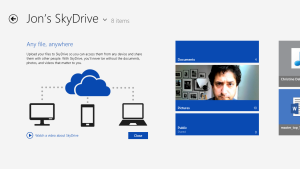
From SkyDrive to SmartGlass to the ability to synchronize settings across environments quickly and easily, the new Windows 8 platform provides the essential core connections for all your software and gear.
Forcing a touchy issue
Since touch is the cornerstone of Windows 8—regardless of whether you actually have a touch-responsive display on your chosen device—Microsoft is pushing third-party developers to take the next big step in app creation. Simply put: Touch cannot be ignored. This mandate is an issue for people without touch-enabled hardware. And it’s bad news for people who have tried touch control but hate it. Yet Microsoft's new “the touch way or the highway” philosophy shows vision and innovation, and affirms the public’s overwhelming support for touch gestures on computing hardware.
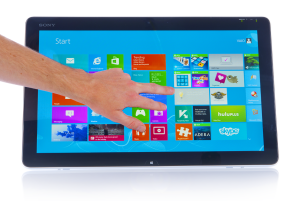
And these are the apps that will ensure a consistent, high-quality user experience, regardless of which hardware you use to tap into the new Windows regime.
Leading by (hardware) example
Microsoft isn’t just reinventing its Windows platform. It’s also doubling down on a hardware strategy designed to lead by example, showing tablet manufacturers that tablet-laptop hybrids are the future of PC computing.

In essence: Consumers get more choice, and better products to pick from. Microsoft, meanwhile, achieves faster market-share gains for Windows 8. The new Surface tablet isn’t just the premier hardware component in the new Windows ecosystem—it’s actually a catalyst for greater ecosystem success.
Fearing giants promotes innovation
Now that Microsoft has committed to the brave new world of touch—and smartphones and tablets—it has to deliver the goods. It’s now competing directly with the iPad and iPhone. It’s now competing with scads of Android devices. This isn’t necessarily an enviable position given Microsoft’s uphill climb, but it will definitely drive innovation, and that bodes well for the Windows ecosystem as a whole.

Apps such as Xbox SmartGlass, and services such as the SkyDrive cloud platform and Xbox Music streaming, are great starts. But what else can Microsoft do to persuade users to abandon their existing devices and ecosystems, and leap head-first into Windows 8? More important, how fast can Microsoft pull that off? These are scary questions for Microsoft, but I think standing in place doing nothing is an even scarier option.
Joining the app-store masses
Apple had one first. Then Google got one. Now, finally, Microsoft has one too: a software store. It’s not for your Windows Phone 8 device, but for Windows itself. And the new Windows Store is the only place you can download “Windows 8 apps,” the Start screen-centric programs previously known as Metro apps.
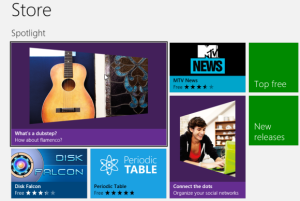
The Windows Store is a great step forward; but in order to recognize its benefits, you can’t look at it through the eyes of a power user. Envision, instead, the typical technological neophyte who wants access to online shopping, streaming movies, financial information, games, rudimentary media editing, and all the other simple services that computers make possible. Throughout their computing lives, these novices have been tempted numerous times: A Web ad has asked them to install something they shouldn’t. Or they’ve installed software upon the recommendation of a friend, but that software isn’t compatible with their system. Or, even sadder, these newbies might not even know how to find and download new programs for their PCs.
The Windows Store gives such users a simple and secure entry point for downloading apps that have passed stringent certification from Microsoft itself. Sure, an app might ultimately stink, but at least users now have strong assurance that the software won’t muck up their systems. To wit: Apple’s App Store went more than five years before succumbing to its first piece of malware, and the company quickly expunged the app so that no new user could download it ever again.
The Bad
Friendly compromises that were never madeTo construct a user experience that works fairly seamlessly across desktops, tablets, and smartphones, Microsoft had to make some compromises, and these trade-offs are affecting desktop users the most. Although it’s relatively easy to operate a touchscreen-oriented interface on a device with an actual touchscreen, it’s not so easy to translate touch gestures to the world of mice and keyboards. Power users aren’t happy with Microsoft’s new Windows 8 mouse gestures, so you can only imagine how well they’ll be received by the enterprise market, and by all of our grandparents.

Want a Start menu? We won’t show it by default, but you can enable it if you really need to. Don’t like the Start screen? That’s totally cool. We’ll make it so that you can still access it, but we won’t force you to deal with it up front each time you start the OS. Don’t need a lock screen since you’re on a desktop computer instead of a tablet? Great. We won’t force you to “reveal” your password prompt. Or at least, we won’t bury the option that lets you eliminate this.
That’s how Microsoft’s internal dialogue could have sounded. But in the real world, Microsoft chose differently. In creating a common ecosystem for Windows 8, Microsoft has shifted portions of its new user interface into places where they don’t need to be.
Common interface, uncommon apps
The scariest part of the Windows 8 ecosystem is the fact that Microsoft has put a good chunk of the potential success of its OS—across PCs, tablets, and smartphones—in the hands of third-party developers. Even though it’s premature to declare Windows 8 a complete dud in terms of available apps, we have to be concerned about the critical dearth of apps that one would otherwise expect to find on a major new platform. Windows 8 has no official Facebook app, no official Twitter app, and no Instagram. And those are just three of the most obvious omissions.

What’s worse for Microsoft is the way that it has decided to treat the Windows Stores on smartphones, tablets, and desktops, walling them off in separate silos instead of unifying all of the environments. How cool would it be to buy a copy of Microsoft Office, and receive a version geared for your Windows 8 smartphone and for your Windows 8 desktop or tablet? Or, for that matter, wouldn’t it be nice to purchase rights to run your favorite Windows 8 smartphone game on your tablet?
But, no, that’s not happening.
A Windows 8 tablet or hybrid is the functional equivalent of a laptop, which shares the same Windows Store as your desktop PC (unless you’re running a Windows RT-based tablet; I'll get into that below). In contrast, a Windows Phone device—whose interface inspired Windows 8 and exhibits many of the same behaviors and features of Windows 8—taps into a completely different software store. Phone apps share a common code with tablet and PC apps, but they can’t directly transfer over to your tablets and PCs.
The sins of Windows RT
If you thought the Windows 8 ecosystem was confusing enough in terms of app support, you ain’t seen nothing yet.
Windows 8 RT has entered the fray, too. If the Windows 8 ecosystem of desktops, laptops, tablets, and smartphones were a great land mass, then Windows 8 RT would be an island off the coast. It’s under the mother country's protection, and it likely enjoys much of the same climate and vegetation, but it’s still separated enough to be its own little, self-contained world.
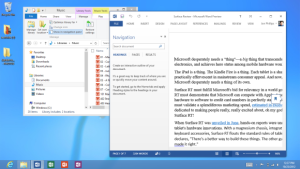
Microsoft might gain some depth-of-ecosystem advantages by opening Windows 8 to inexpensive (and energy-efficient) ARM processors; in fact, the move to support ARM extends the reach of the new Windows platform. But Windows RT also has the potential to create serious confusion for people expecting to jump between all Windows 8 devices without issues.
It’s commercial time
Never before has Microsoft been so unapologetic about tying its commercial interests so closely with the raw mechanics of its OS ecosystem. Although you’re free to set up your own default applications in Windows 8, or to install other apps to manage the multimedia as you see fit, there’s no question that Microsoft would prefer that you use its branded, tiled apps to watch or listen to content. And, oh, while you’re there, perhaps you might like to rent or purchase a movie or two from one of the tiles advertised on your screen.
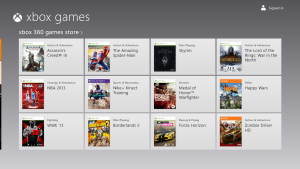
Android—and even iTunes, to a lesser extent—separates commercialization from content to such a degree that it’s there if you want it, and you know how to reach it, but it isn't in your face, atop a lackluster multimedia player (or games browser). But in the new Windows ecosystem, no matter what you’ve paid for your device or for your subscription content, advertising is now a part of the norm. That’s not fun.
Region migration?
Although this issue won’t affect the mainstay of Microsoft’s Windows 8 user base, one of the problems Microsoft has now created in unifying its ecosystem under a common account—the Microsoft Account—is that transferring your account between regions is about two degrees short of impossible. In other words, if you’ve done a lot with your old Live ID in Europe, for instance, and are about to move to the States, you’re in for a bit of a shock: Your new Microsoft Account will remain tied to the country where you created it.
Unfortunately, at the moment you can't just open a drop-down menu in some options panel and change over from, say, England to the United States. Without the ability to make such a switch, users lose the capability to pay for the very services Microsoft offers—apps, Xbox Live points, and the like—in addition to losing access to any region-locked apps, games, services, or subscriptions they’ve already ponied up for.
What would have been an annoying issue in previous years is even worse now that Microsoft is tying a number of Windows 8’s more compelling features to a user’s online account. Microsoft’s standard solution—create a new Microsoft Account—just doesn’t cut it anymore, not when the goal is to have a single sign-on for the entirety of the Windows 8 ecosystem.
The real solution is twofold. First, Microsoft should give its users the opportunity to switch their billing country without hassle. And second, those people who already took Microsoft up on its advice to create multiple accounts need the ability to merge multiple accounts into one.
Microsoft, however, would just prefer that you “hold tight” for now.

No comments:
Post a Comment